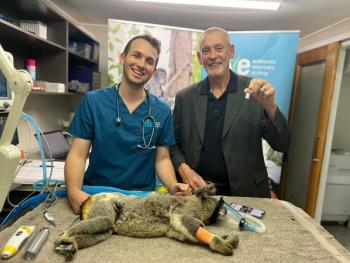
ClinQuiz: Increase your zoonotic parasite prowess-References
Reference list for ClinQuiz: Increase your zoonotic parasite prowess
1. Gavignet B, Piarroux R, Aubin F, et al. Cutaneous manifestations of human toxocariasis. J Am Acad Dermatol 2008;59(6):1031-1042.
2. Won KY, Kruszon-Moran D, Schantz PM, et al. National seroprevalence and risk factors for zoonotic Toxocara spp. infection. Am J Trop Med Hyg 2008;79(4):552-557.
3. Eberhard ML, Alfano E. Adult Toxocara cati infections in U.S. children: report of four cases. Am J Trop Med Hyg 1998;59(3):404-406.
4. Dubey JP, Jones JL. Toxoplasma gondii infection in humans and animals in the United States. Int J Parasitol 2008;38(11):1257-1278.
5. Dubey JP. Duration of immunity to shedding of Toxoplasma gondii oocyts by cats. J Parasitol 1995;81(3):410-415.
6. Wallace GD. Isolation of Toxoplasma gondii from the feces of naturally infected cats. J Infect Dis 1971;124(2):227-228.
7. Dubey JP, Hoover EA, Walls KW. Effect of age and sex on the acquisition of immunity to toxoplasmosis in cats. J Protozool 1977;24(1):184-186.
8. Kapperud G, Jenum PA, Stray-Pedersen B, et al. Risk factors for Toxoplasma gondii infection in pregnancy. Results of a prospective case-control study in Norway. Am J Epidemiol 1996;144(4):405-412.
9. Shuhaiber S, Koren G, Boskovic R, et al. Seroprevalence of Toxoplasma gondii infection among veterinary staff in Ontario, Canada (2002): implications for teratogenic risk. BMC Infect Dis 2003;3:8.
10. Conrad PA, Miller MA, Kreuder C, et al. Transmission of Toxoplasma: clues from the study of sea otters as sentinels of Toxoplasma gondii flow into the marine environment. Int J Parasitol 2005;35(11-12):1155-1168.
11. Lopez A, Dietz VJ, Wilson M, et al. Preventing congenital toxoplasmosis. MMWR Recomm Rep 2000;49(RR-2):59-68.
12. Curtis CF. Current trends in the treatment of Sarcoptes, Cheyletiella, and Otodectes mite infestations in dogs and cats. Vet Dermatol 2004;15(2):108-114.
13. Moriello KA. Zoonotic skin diseases of dogs and cats. Anim Health Res Rev 2003;4(2):157-168.
14. Greiner, EC. Diagnosis of arthropod parasites. In: Zajac A, Conboy G, eds. Vet Clin Parasitol 7th ed. Oxford, England: Blackwell Publishing, 2006;185-263.
15. Dryden MW, Blakemore JC. A review of flea allergy dermatitis in the dog and cat. Companion Anim Prac 1989;19:10-17.
16. Perez M, Bodor M, Zhang C, et al. Human infection with Ehrlichia canis accompanied by clinical signs in Venezuela. Ann NY Acad Sci 2006;1078:110-117.
17. Centers for Disease Control and Prevention (CDC). Anaplasma phagocytophilum transmitted through blood transfusion—Minnesota, 2007. MMWR Morb Mortal Wkly Rep 2008;57(42):1145-1148.
18. Bakken JS, Krueth JK, Lund T, et al. Exposure to deer blood may be a cause of human granulocytic ehrlichosis. Clin Infect Dis 1996;23:198.
19. Elchos BL, Scheftel JM, Cherry B, et al. Compendium of veterinary standard precautions for zoonotic disease prevention in veterinary personnel. J Am Vet Med Assoc 2008;233(3):415-432.
20. Paddock CD, Childs JE. Ehrlichia chaffeensis: a prototypical emerging pathogen. Clin Microbiol Rev 2003;16(1):37-64.
21. Buller RS, Arens M, Hmiel SP, et al. Ehrlichia ewingii, a newly recognized agent of human ehrlichiosis. N Engl J Med 1999;341(3):148-155.
22. Hinkle NC. Delusory parasitosis. Am Entomol 2000;46(1):17-25.
23. Hsu CK, Hsu MM, Lee JY. Demodicosis: a clinicopathological study. J Am Acad Dermatol 2009;60(3):453-462.
24. Divani S, Barpakis K, Kapsalas D. Chronic blepharitis caused by Demodex folliculorum mites. Cytopathology 2009;Mar 7. [Epub ahead of print].
Newsletter
From exam room tips to practice management insights, get trusted veterinary news delivered straight to your inbox—subscribe to dvm360.






